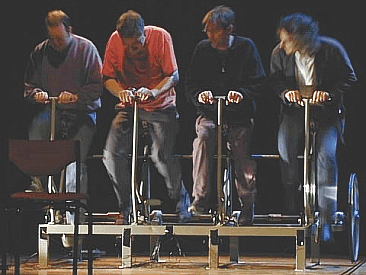 Nord Modular Day 2000
Nord Modular Day 2000 Nord Modular Day 2000
Nord Modular Day 2000
Introduction by Rob Hordijk
Remodelling old analog synths is lots of fun and you can learn a lot from doing so. Imho most fun is to more or less emulate one and then add features not found on the original. The idea is simple use a controllable oscillator (VCO) for the pitch, a controllable filter (VCF) to change the timbre and a controllable amplifier (VCA) to control the volume. A noise generator is present parallel to the VCO to make unpitched sounds. The control signals come from the keyboard, low frequency oscillators (LFO's) and/or envelope generators (ADSR), and lots of knobs of course. Prepatched synths were mostly very simple in their setup, the simple ones like e.g. a Yamaha CS10 featured one VCO and noise, one 12dB filter, two ADSR's and one LFO to modulate filter cutoff, vco frequency or pulsewidth or volume. The more elaborate ones featured one or more extra VCO's, and maybe a ringmodulator, oscillator sync and/or FM and 24dB filters. Sometimes a S&H was added.
So the most common basic patch looks like this:

In the NM the VCA is contained in the envelope modules, or you can use a gain controller module from the mixers tab as a VCA.
The polysynths used chips that contained a complete module, famous are the Curtis and SSM chips. Curtis had two basic filter designs, a 24dB (CEM3320) and a dual 12dB design (CEM3360), SSM made the SSM2040, considered to be the best sounding filterchip, the SSM2044 and SSM2045. The 2044 was used a lot by Korg, e.g. MonoPoly and Polysix, and sounds a bit 'Japanese' (a little bit thin) compared to the CEM3320, that sounds more 'american'. Roland had its own proprietary filterchip but used the Curtis CEM3340 for VCO's a lot, e.g. in the SH-101.

Photo Gemeentemuseum Den Haag
The reason the analog filters sound different is mostly due to the fact that the active elements used in filters are slightly non-linear. The designers had to make a choise between making them as linear as possible but more noisy, or less noisy but more distortion. To add to this, for every 6 dB's in a filter a capacitor has to be used. These are not the most precise electronic components, tolerances in value are typically 10% to 20%. On a real big expensive system these components might have been handpicked, but on a commercial model they used 'small tolerance' 3% capacitors if you were lucky. Differences in capacity introduce different phaseshifts in the filtersections and can make the filters of two of the same synths sound different. And over time values change due to component aging.
Digital filters are so perfect that it is almost impossible to make a single filter that can be tweaked to sound like all those analog filters available in the past. But by combining different types of filters and some slight distortion before or after the filter you can make the NM sound pretty vintage.
The filter has to be placed after the oscillator of course, but the reason the envelope is after the filter on vintage synths is to suppress as many noise as possible if no note is played. On a digital synth like the NM the signal to noise ratio (aliasing noise) is so small that you can safely place a filter after the envelope.
Try to download pictures of old synths as the signal routing is mostly printed on the knob surface. There's lots of them on the net.
Messed up one of your patches, if its an improvement is a matter of taste.
Pictures taken by
Ake Danielson during the performances
@u!
Jan Borgers, Paul Klaui en Marian Zult
The Hague
Analogue versus Digital and some Cello

Modular Einzats Kommando
Cologne

Modular Einzats Kommando
Cologne
4 micro's and speakers on their helmets...

Bikers
Kees v/d Maarel, Wout Blommers, Roland Kuit en Rob Hordijk
The Hague
A prepared 4 man emergency generator driving devise...

Malte Steiner
Hamburg
A 4 Slot Nord Modular performance

String Trio
Roland Kuit, Wout Blommers and Rob Hordijk
The Hague
The 4th man was missing, so it became a trio J
The bows made electrical contact to trigger three Nord Modulars